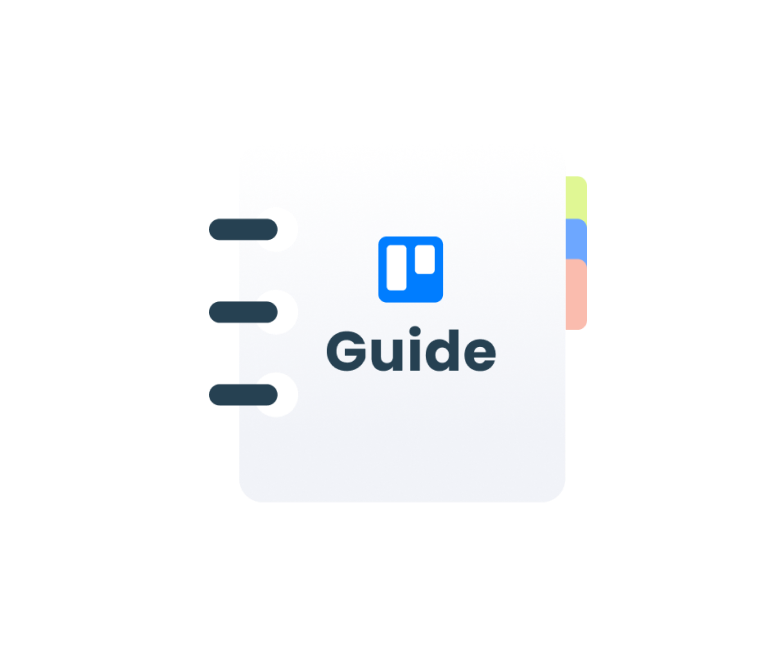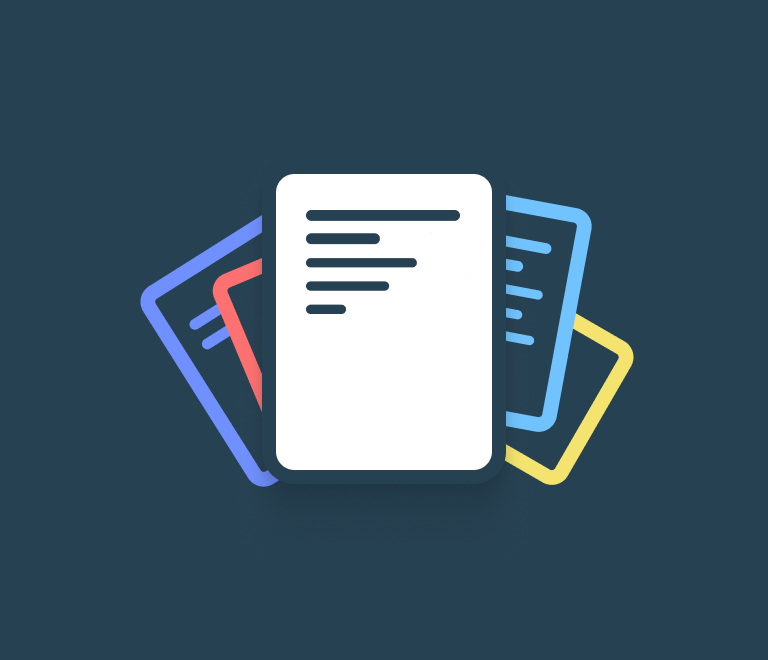Project Manager’s Quickstarter
Top 10 Jira roadmap plugins in 2025
We’ve explored the most popular Jira roadmap plugins you can find on the Atlassian marketplace that can help teams plan and execute their projects more efficiently. From customizable roadmaps to real-time progress tracking, these plugins offer a range of features that can help achieve your business objectives.
All of these roadmapping tools have their pros and cons, so let’s check them out to see which one works best to build a clear, concise, and effective roadmap for your team.
- Planyway – detailed roadmap, project portfolio view, advanced share options
- EasyAgile – swimlane-based roadmap, milestone synchronization
- Swanly – focus on high-level streams of work, multi-project view
- Jira built-in timeline – advanced portfolio management, scenario planning, inflexible pricing
- Structure – customizable issue hierarchy, flexible reporting, project dependencies management
- ProductGo – mix of user personas, user story mapping and roadmap
- Epic Roadmap – focus in epics management, milestone tracking, project goal alignment
- BigPicture – flexible roadmap views, multi-project portfolio management, advanced resource planning
- Tempo – resource management, budget tracking, mobile availability
- Aha! Roadmaps – capacity planning, integration with multiple tools, define product and business goals
1. Planyway
Planyway is a Jira plugin that provides a visual Jira roadmap feature for teams. It allows teams to create and manage their roadmap directly within Jira, providing a seamless integration with other project management capabilities like calendar, workload planner for deep resource planning and time tracking.
Key features
The beauty of Planyway roadmap plugin is that it allows you to build your roadmap from different perspectives thanks to grouping options, all organized on a swimlane-based structure.
You can group it by:
- Users: you can group tasks by team members to see who is working on which tasks at any given time.
- Epics: allows a high-level view of work based on Epics and how each one is progressing.
- Teams: you can organize tasks by different teams, which is great for cross-team visibility and coordination. Especially when one team work on one product. Example, Development and Marketing team should align their actions.
- Projects: offers a project portfolio roadmap, allowing you to track the progress of multiple projects at once.
- Components: allows grouping by Jira components for more technical or modular views of the tasks.

Custom export options
Planyway allows exporting the roadmap to PDF, CSV, and XLSX formats. This is very convenient if you need to discuss the roadmap with external stakeholders or show it to a client.
The product also provides visualization of releases, milestones, and various filtering options: by completed tasks, epics, projects, and more.
Portfolio management
For Jira project portfolio managers, it can be more important to view not a detailed roadmap with tasks and assignees for each project, but a general roadmap for the portfolio with key jira milestones for all projects. Moreover, the roadmap helps to quickly assess the risks of projects not being completed on time.
The color-coding for weekends also allows for a more accurate assessment of the team's members' workload.
You can also flexibly customize the card view in the Planyway roadmap to avoid visual overload and only see the most essential information.
Collaboration and sharing
For communication with stakeholders, in Planyway, you can create a link and send it to any team member registered in Jira. This allows you to set up multiple roadmaps with the required customization and send them to different team members.
One of the key advantages of Planyway is the ability to not just "view" the completed roadmap, but also create tasks and, using the drag-and-drop method, immediately place them onto the roadmap. This significantly reduces planning time.
✅Pros:
- Visualizes all issue types: automatically visualizes issues with easy filtering.
- Customizable: group tasks by users, epics, teams, components, or projects for different views.
- Multi-project view: manage multiple Jira projects in one roadmap.
- All-in-one tool: includes roadmap, calendar, workload planner, and time tracking.
- Easy to use: simple interface with drag-and-drop functionality.
- Real-time updates: keeps the roadmap up to date as changes occur.
- Cross-functional collaboration: align teams, epics, and components for better coordination.
- Improved project visibility: clear roadmap for tracking milestones and progress.
❌ Cons:
- Limited integrations: Planyway integrates only with Jira, lacking support for external apps like calendars and third-party tools, which may limit workflow automation for teams using multiple platforms.
- Limited scalability: performance may slow down for large teams or projects with numerous tasks, affecting efficiency when managing multiple complex roadmaps.
- No Gantt hierarchy: the tool lacks a traditional Gantt chart view for detailed task dependencies and scheduling, which could be a limitation for users who prefer classic Gantt visualizations.
- No offline access: Planyway requires an internet connection to function fully, making it less suitable for teams in areas with limited connectivity or those who need offline access.
💰Price: Free for teams up to 10 members, then USD 3.00 per user for bigger teams
📊 Hosting Options: Cloud, Data Center
⭐ Rating: 3.5/4
2. Easy Agile Roadmaps
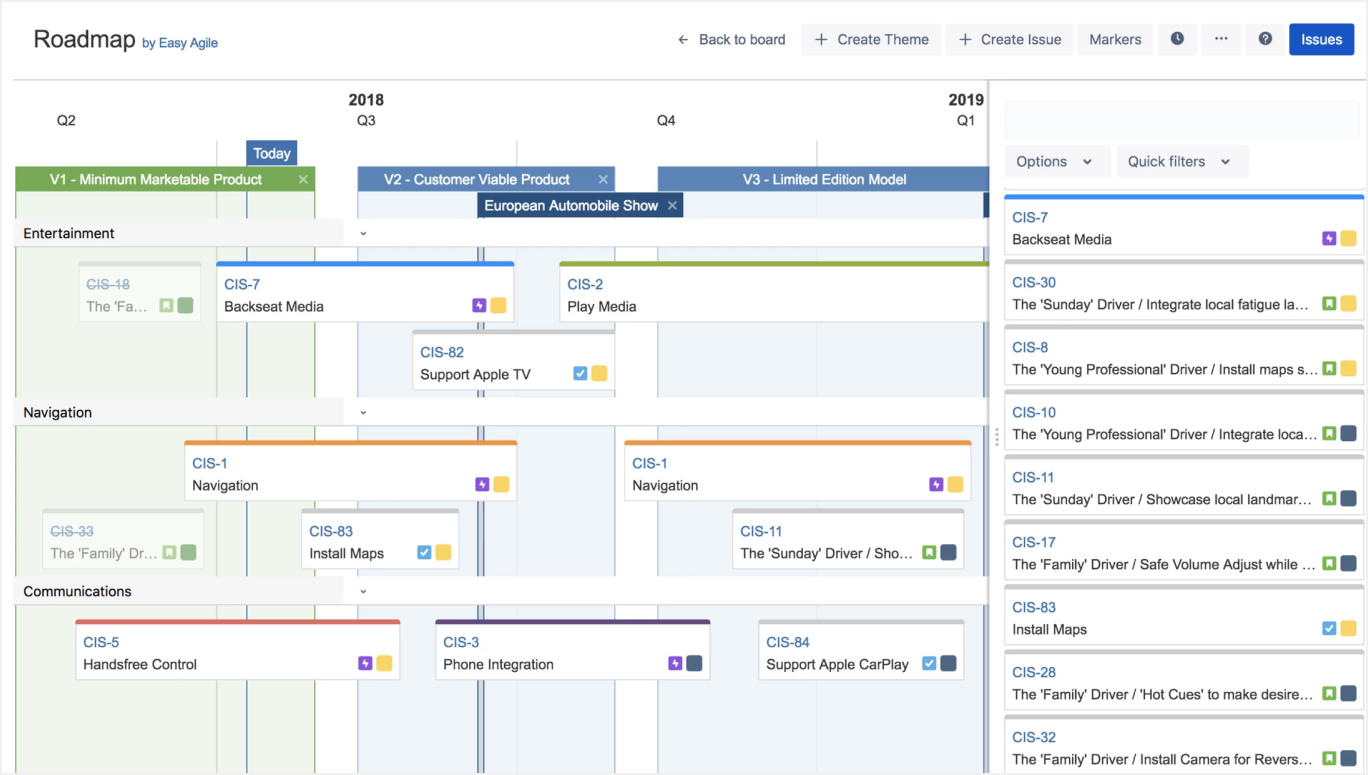
Easy Agile is an app focused solely on creating roadmaps, helping teams align around the project vision and understand its direction. In addition to standard project visualization, it enables users to group issues into high-level streams of work that represent different teams or customer outcomes.
The main feature of the service is working with the roadmap in the form of Theme Swimlanes. This allows you to structure tasks in the roadmap by grouping them into key areas or themes, such as specific teams, projects, or goals. By using Swimlanes, you can easily visualize how different work elements (such as epics, tasks, or initiatives) relate to one another and are distributed across themes. This makes it easier to understand which tasks are associated with the same goal or outcome and helps track their progress, improving planning and coordination efficiency.
However, Easy Agile has some limitations: exports are only available in PDF format, and it's not possible to share links to the completed roadmap. While you can quickly add milestones directly from the visualization, creating new tasks requires you to return to the Jira board.
✅ Pros:
- User-friendly interface: Easy Agile Roadmaps offers an intuitive interface, making it easy for teams to get started quickly.
- Theme/team swimlanes: theme swimlanes let you group issues into high-level work streams, representing customer outcomes or team efforts.
- Free for up to 10 users: the free plan makes the app accessible for small teams, providing core features at no cost.
❌ Cons:
- PDF export only: the app only supports PDF export, which may limit the flexibility of sharing and customizing the roadmap compared to other formats like CSV or XLSX.
- Cannot add new tasks: you cannot create new tasks directly within the Easy Agile interface; tasks need to be added through the Jira board, which can interrupt workflow and slow down planning.
- Limited integrations: while it integrates well with Jira, Easy Agile Roadmaps doesn’t support integrations with other third-party tools, limiting its ability to connect with a broader tech stack.
💰 Price: Free for teams up to ten members, then $1.75 per member
📊 Hosting Options: Cloud, Data Center
⭐ Rating: 3.0/4
3. Swanly
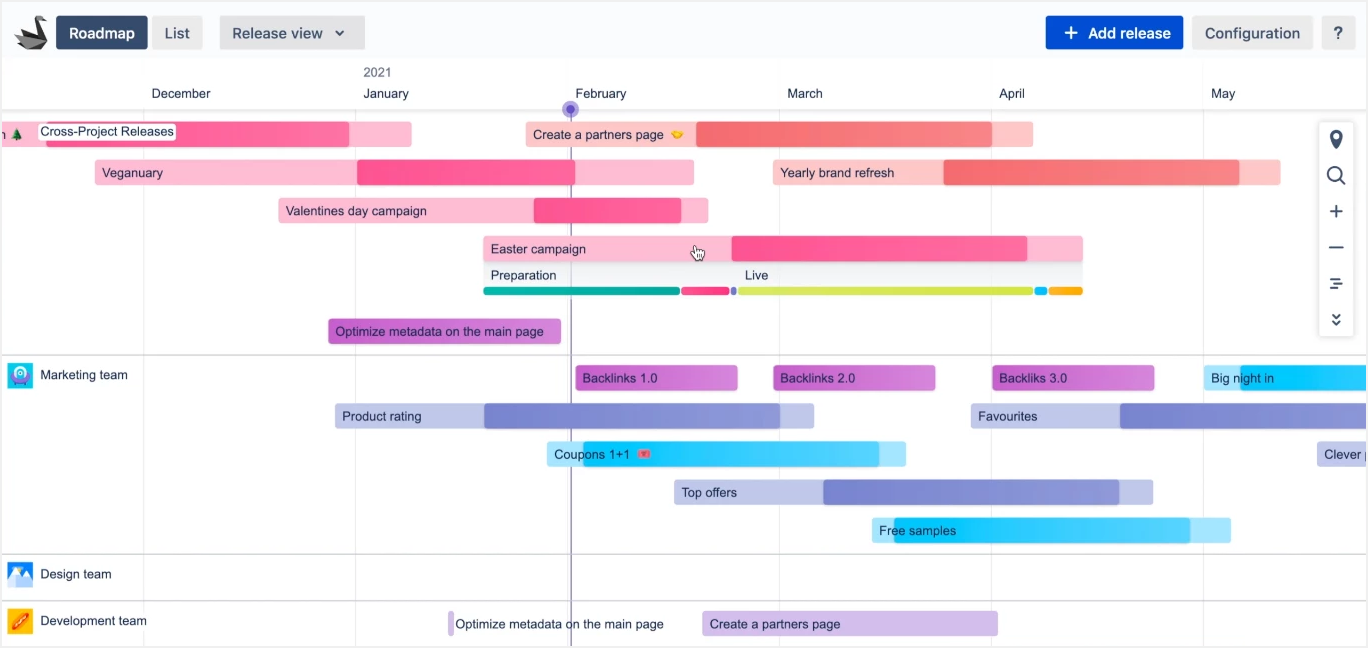
Swanly was created with the idea of clear data visualization across projects, reached through roadmaps and dashboards. The tool gets access to all Jira projects and is able to provide you with a portfolio issue roadmap to view any issue from any project, a project release roadmap to centralize releases and create cross-project releases with sync versions.
Along with the roadmaps, Swanly can show data in the list view to see high-level data like name, status, type, progress, description, and start & end dates in one place.
Reporting is another plus that lets you have insights into each of your releases. You get access to all details needed including the scope progress, time or story point progress, burndown chart, and lots more.
✅ Pros:
- Advanced reporting: Swanly offers advanced reporting features that allow teams to generate reports on their roadmap progress, team performance, and more. This feature enables teams to gain insights into their work and identify areas for improvement.
- Free for 10 users: the app doesn’t charge small teams.
- Structured hierarchical view: Swanly provides a clear project hierarchy, so you can easily navigate between interdependencies.
- Customizable: roadmap timeline can be grouped by project, status, fix version and more.
❌ Cons:
- No resource allocation: Swanly provides a general roadmap view and doesn’t let you structure it by team members, which might be a disadvantage for those who require more resource management capabilities.
- Only Epic visualization: the app visualizes only epics on the roadmap, not other issue types.
- Limited integrations: Swanly doesn’t support any external integrations.
- No Data Center: Swanly had only the Cloud version. There is no option for Data Center.
💰 Price: free for teams of up to 10 members, then $1.50 per user
📊 Hosting Options: Cloud
⭐ Rating: 3.3/4
4. Jira built-in timeline
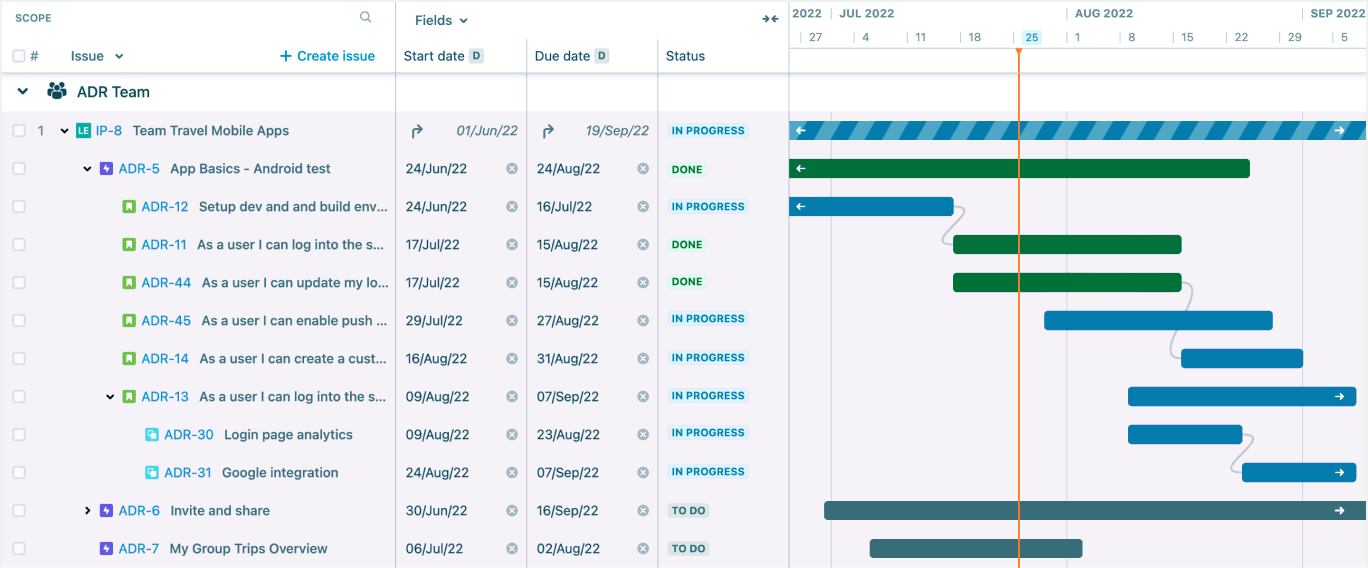
Jira built-in timeline (Advanced Roadmap) is a powerful Atlassian Jira roadmap tool that enables teams to plan and track multiple projects and their interdependencies. It offers real-time insights into the progress of individual projects and their impact on the overall roadmap.
One of the standout features of Advanced Roadmap is its ability to handle complex project dependencies, which is essential for larger teams working on interrelated tasks. By clearly visualizing dependencies between issues, teams can prevent bottlenecks and ensure that the work moves forward efficiently. Unlike Jira's basic features, Advanced Roadmap includes team capacity planning and allows tasks to be allocated based on team workload, which improves resource utilization efficiency.
✅ Pros:
- Advanced portfolio management: the add-on offers advanced portfolio management features, including scenario planning, what-if analysis, and Jira capacity planning.
- Team allocation: teams allow you to group and filter work based on teams, and manage the allocation of work on the Jira product roadmap based on capacity.
- Dependencies: Advanced Roadmap offers the dependency feature, which is useful for tracking interconnections between issues.
❌ Cons:
- Cost: Advanced Roadmap can only be purchased in the Jira Premium subscription, which is quite costly for smaller teams or organizations with a limited budget.
- Complicated onboarding: as the solution offers lots of roadmapping features, the onboarding process can be quite difficult for your teammates.
💰 Price: included into Jira Premium subscription that costs $15.25 per user monthly
📊 Hosting Options: Cloud, Data Center
5. Structure
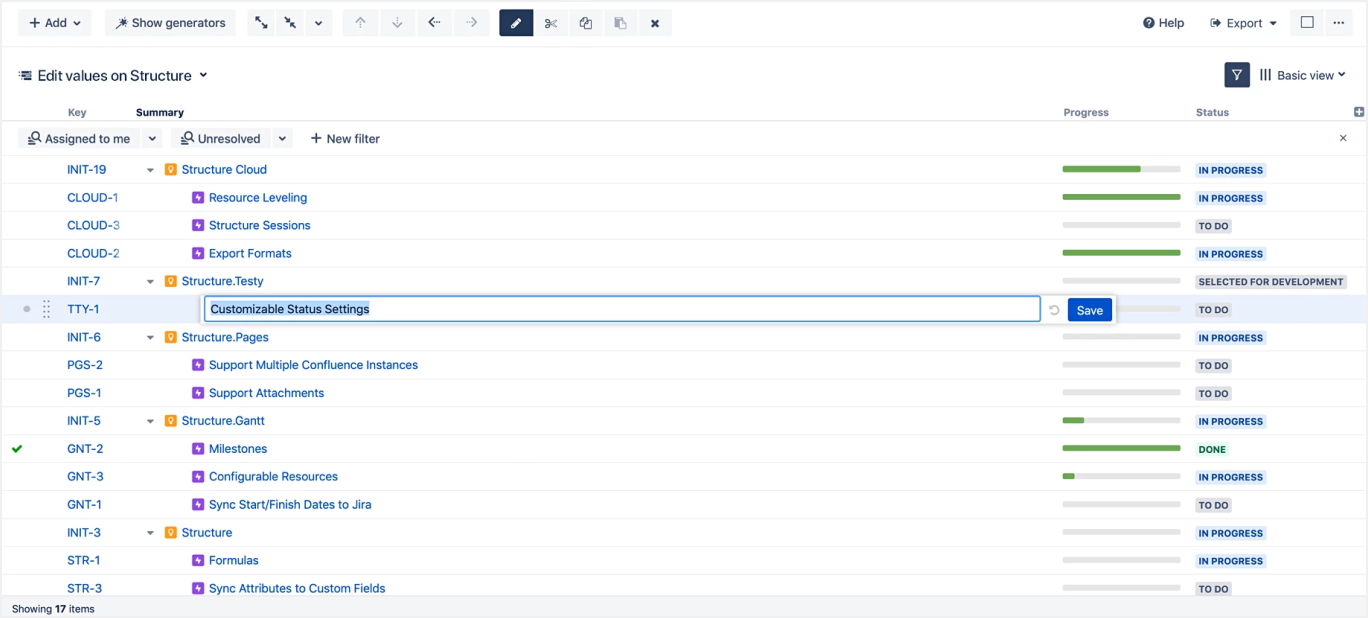 Structure for Jira is a plugin that enables teams to create and manage hierarchies within Jira. With Structure for Jira, teams can organize their roadmap by epics, themes, and initiatives. It provides real-time visibility into the progress of each component of the roadmap.
Structure for Jira is a plugin that enables teams to create and manage hierarchies within Jira. With Structure for Jira, teams can organize their roadmap by epics, themes, and initiatives. It provides real-time visibility into the progress of each component of the roadmap.
Structure for Jira offers the ability to create a Work Breakdown Structure (WBS), allowing teams to break down large projects into smaller, more manageable parts. This feature enables a clear visualization of the project's hierarchy, making it easier to track progress and understand task dependencies. By organizing work in a structured way, teams can monitor each component's status, identify bottlenecks, and ensure that all parts of the project are progressing as planned, ultimately enhancing project management efficiency.
The plugin also offers two working modes:
- Speed mode
- Power mode
Power mode allows you to build a roadmap using presets or a generator. It is also in Power mode where flexible customization options are embedded.
✅Pros:
- Easy start: thanks to Speed mode, you can start working with the roadmap in just a couple of minutes, making it ideal for quick setups and immediate use.
- Portfolio view: the app lets you visualize a roadmap across multiple projects.
- Task hierarchy: organize tasks into customizable hierarchies, helping teams manage complex projects and dependencies efficiently, ensuring nothing is overlooked.
- Reporting: you can write formulas to sum values, calculate time in status, group & sort data, etc. and further transform it into valuable reports.
❌ Cons:
- Cost: Structure doesn’t have the free plan. So, even small teams are charged for the service.
- Resource management: while Structure for Jira offers a range of customization options, it has very modest resource management capabilities.
💰 Price: Starts with $1 per user in small teams. The price rises for bigger teams.
📊 Hosting Options: Cloud, Data Center
⭐ Rating: 3.5/4
6. ProductGo
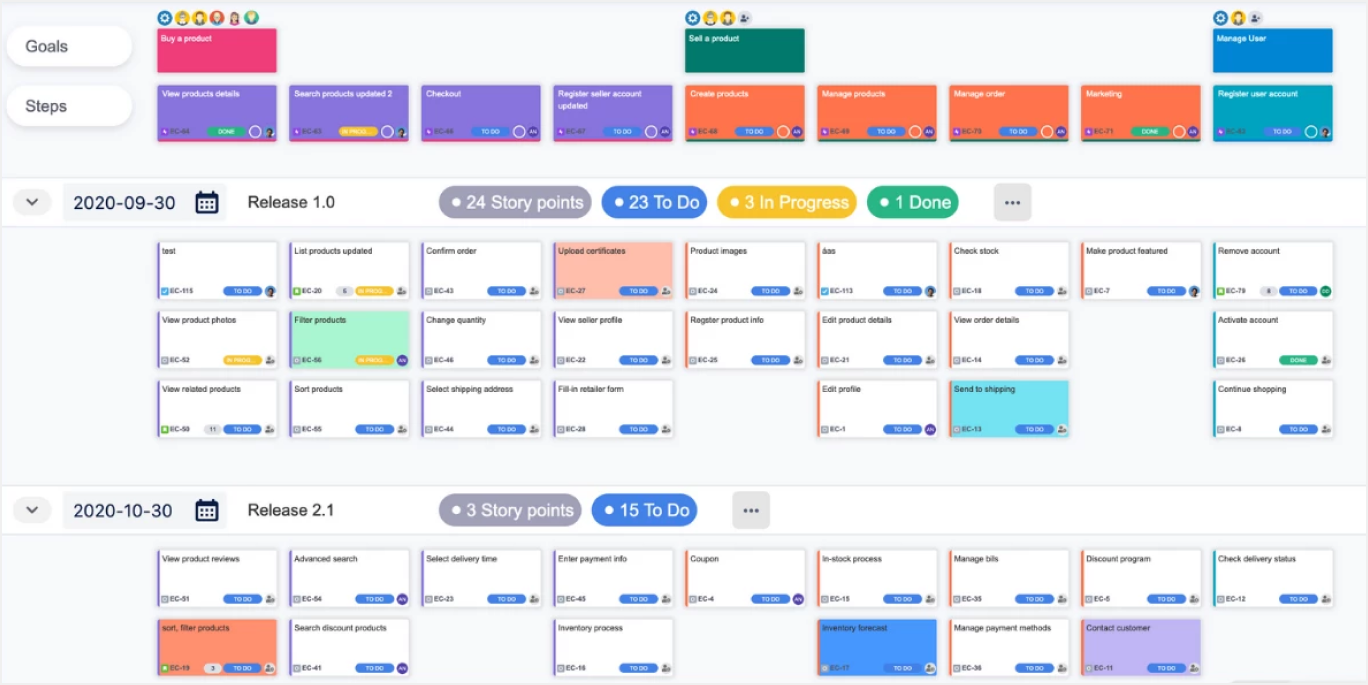
This add-on combines two major views — a user story map and a product roadmap, allowing you to see the big picture from a user's perspective. You can work in the no-swimlane mode or split your story map into release and sprint swimlanes. The same can be done for the roadmap, providing you with a release and sprint timeline.
The app grants easy navigation thanks to filtering issues to display only what’s needed, as well as data export to share your workflow with stakeholders.
Additionally, ProductGo allows you to create user personas. You can link these personas to user stories and then visualize tasks not only by priorities but also by personas. This feature helps teams better understand and address the specific needs and behaviors of different user segments, making the planning and execution of tasks more user-centered.
✅ Pros:
- User story mapping: Agile User Story Map & Product Roadmap offers a user story mapping feature that allows teams to break down complex projects into smaller, more manageable pieces. This feature enables teams to prioritize tasks, identify dependencies, and plan releases more effectively.
- Multi-projects view: the addon visualizes issues from multiple Jira projects on the same view.
- Free for 10-user teams: the app is totally free for small teams.
❌ Cons:
- Sophisticated interface: while a combination of a user story map and a project roadmap is a powerful thing, you may find the interface very crowded with elements.
- Limited integrations: same as most of the competitors, the app doesn’t support any external integrations.
💰 Price: free for teams which have fewer than 10 members, and then $1.25 per user (average)
📊 Hosting Options: Cloud, Data Center
⭐ Rating: 3.3/4
7. Epic Roadmap
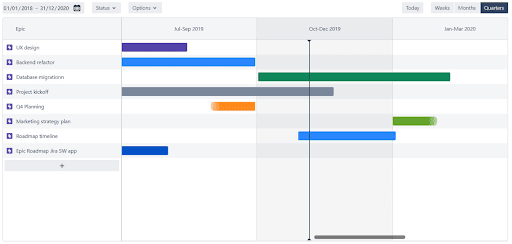
Epic Roadmap specializes in managing epics — the large chunks of work within a project. Unlike other tools that focus on individual tasks or subtasks, Epic Roadmap is centered around larger initiatives and their progress. This allows teams to see the bigger picture and track the long-term goals of the project, providing a clearer strategic view and better management of larger project milestones.
Epic Roadmap is focused on strategic planning, making it ideal for large projects where it’s important to see long-term goals and dependent tasks. This sets it apart from other tools that often focus on micro-tasks or detailed aspects, instead of providing an overview at the epic and large project stage level.
✅ Pros:
- Easy to use: Epic Roadmap offers a user-friendly interface with a very straightforward interface.
- Milestones management: Epic Roadmap is designed to help teams manage milestones by mapping their roadmap to key business goals and objectives. This allows teams to track significant achievements and deadlines, ensuring alignment with overarching project milestones.
❌ Cons:
- Only Data Center: the addon doesn’t support the Cloud version, so you can only host it on your side.
- Shows epics only: Epic Roadmap is able to visualize only one issue type — epics, which might be too limited for certain workflows.
💰Price: Data center version becomes available from $300 per year.
📊 Hosting Options: Data Center
⭐ Rating: 3.3/4
8. Big Picture
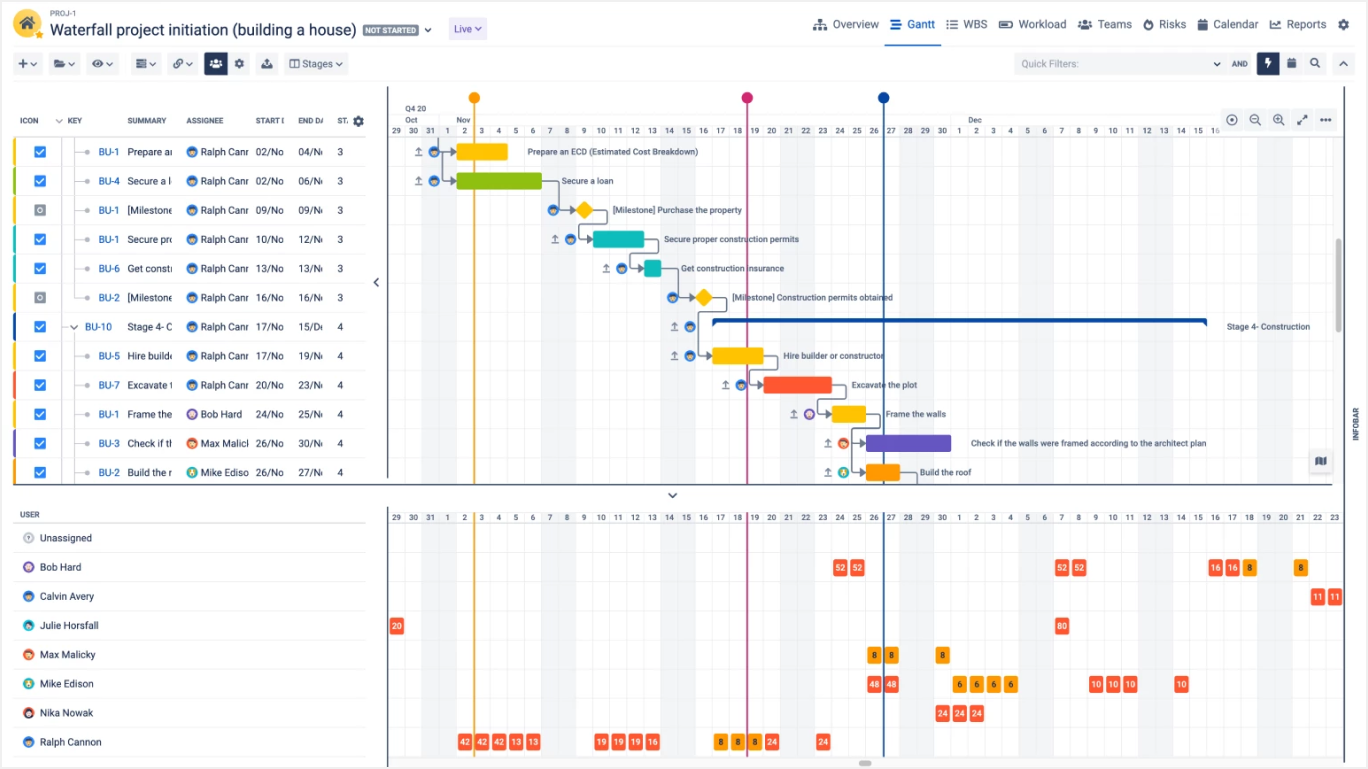
BigPicture for Jira is a project management plugin that includes a roadmap feature. It offers a customizable roadmap that can be tailored to fit the needs of different teams.
The plugin is suitable for both Agile teams and more traditional Waterfall approaches. It supports the creation of sprint scenarios, backlogs, and other elements for Agile projects, and can also be used for more linear processes in Waterfall approaches.
BigPicture offers multi-layered visualization, including plans at the task, epic, project, and portfolio levels, allowing managers to see both the overall progress and the details at a lower level. The roadmap in BigPicture also allows for resource planning, providing a visualization of team workload, which helps manage task allocation and avoid overloading project participants.
✅ Pros:
- Resource allocation: BigPicture offers resource allocation features that help to manage team workload more effectively.
- Advanced features: BigPicture offers a range of advanced features such as Gantt charts, dependency management, and what-if analysis.
- Free for up to 10 users: BigPicture is completely free for small teams.
❌ Cons:
- Slow: there are lots of reviews pointing at the low speed of the addon.
- Cost: BigPicture is a more expensive app compared with similar solutions.
- Unintuitive UI: it will require some time for you to get used to the interface. So, then team onboarding might be a difficult thing to do.
💰 Price: Free for 10-user teams, then USD 3.75 per user monthly.
📊 Hosting Options: Cloud, Data Center Rating: 3/4
9. Tempo Planer
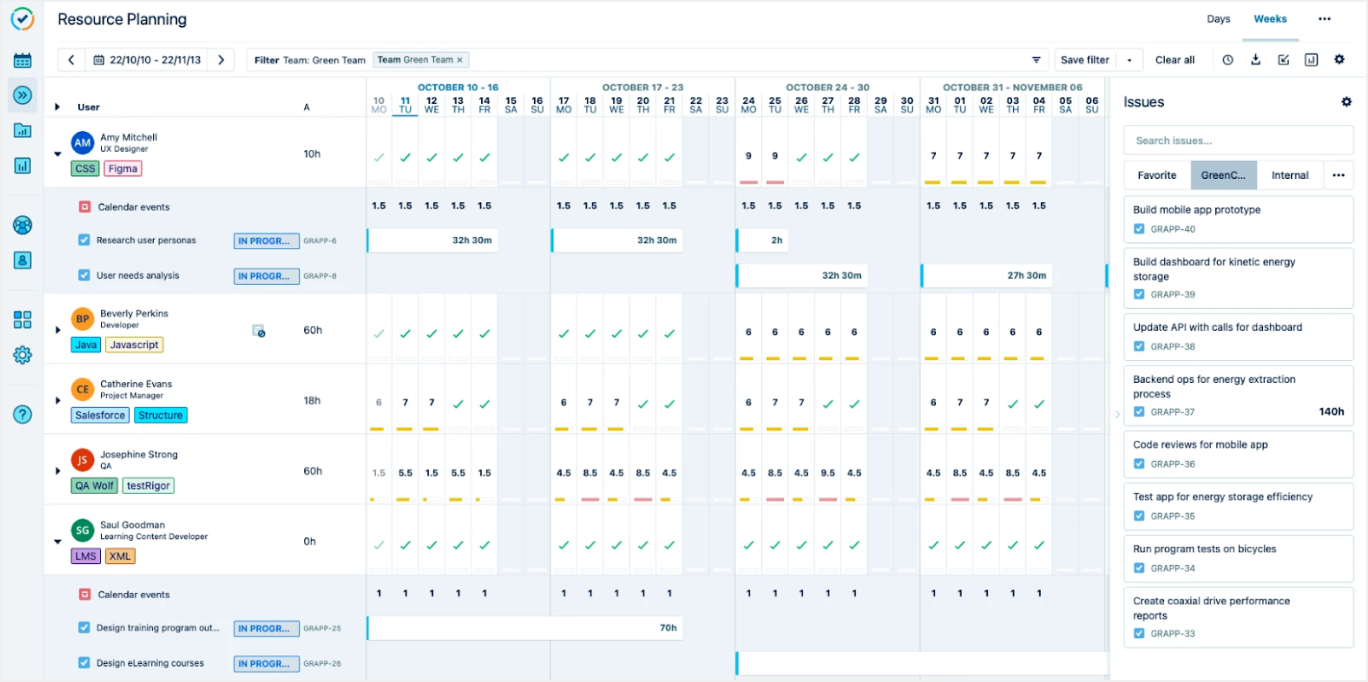 Tempo Planner for Jira is a plugin that enables teams to plan their resources and capacity. It offers a high-level roadmap that shows the availability of team members and their planned work.
Tempo Planner for Jira is a plugin that enables teams to plan their resources and capacity. It offers a high-level roadmap that shows the availability of team members and their planned work.
Tempo Planner for Jira also provides a detailed view of each team member's workload, which enables teams to allocate resources more efficiently.
✅ Pros:
Resource allocation: Tempo Planner primarily focuses on workload management which means you’ll have lots of options for capacity planning. This functionality enables teams to allocate resources across multiple projects, ensuring that the right people are working on the right tasks at the right time.
Mobile app: Tempo Planner had the mobile version which makes it possible to manage team work on the go.
❌ Cons:
- Focus on team members: the app allows you to plan time by team members only, not by projects. So, if you’re looking for a more classical roadmapping tool, it might make sense to switch your attention to other solutions.
- Complexity: Tempo Planner offers advanced features that may require a learning curve for new users. Teams may need to invest time in training and onboarding to fully utilize the tool's capabilities.
- Cost: Tempo Planner doesn’t offer any free plans.
💰 Price: Starts from USD 1 per user monthly, then the price rises as your team gets bigger.
📊 Hosting Options: Cloud, Data Center
⭐ Rating: 3/4
10. Aha Roadmaps
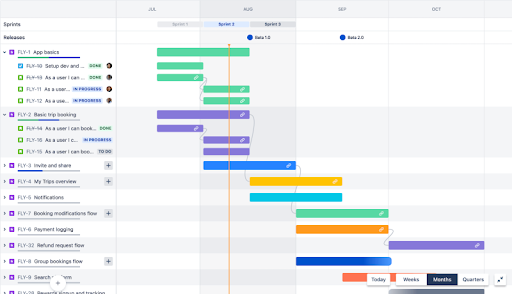
Aha! Roadmaps is a Jira plugin with lots of integrations for improving the process of product development. It has a list of the basic features to create interactive product roadmaps, reporting on progress, sharing roadmap presentations, and more.
✅ Pros:
- Integration: Aha Roadmaps integrates seamlessly with other project management tools such as Trello, enabling teams to access their roadmap alongside other project management features. This integration eliminates the need for teams to switch between different tools, streamlining their workflow and saving time.
- Support team: there are lots of good reviews for great support in case of questions or issues.
❌ Cons:
- No Data Center: the app only supports the Cloud version.
- Need for third-party vendors: The app can not be purchased the usual way on the marketplace page. You’ll have to initiate the sales process through a third-party vendor.
- Learning curve: Aha Roadmaps may require a learning curve for new teams, so the onboarding process might be quite sophisticated.
💰 Price: No open pricing. The app can only be purchased through third-party vendors.
📊 Hosting Options: Cloud
⭐ Rating: 3.9/4
How to create roadmap in Jira
Here's a quick Jira roadmap tutorial if you choose to stick to the built-in option and the interactive demo on how to create a roadmap in Jira.
What is the difference between Jira timeline vs roadmap? Actually, these two terms in the Jira universe are absolutely the same. Atlassian is experementing with different namings, as well as the third-party apps, but the feature stays the same. So, when you find Jira roadmap information in Google, it's also applicable to the timeline which is now available in the app instead the roadmap.
Why do you need a Jira project roadmap?
Creating a Jira project involves many variables that you will need to keep track of. And while managing everything just with the means of Jira boards seems too overwhelming, a visual project roadmap grants you an illustration of your workflow over time which can help you:
1. Keep everyone focused on the same goals
As the roadmap is a pure visualization of the work to be done to achieve your goals and objectives, it can pass this idea to the whole team making it clear why they do what they do and what they need to reach by the end of their path. Also, roadmap planning serves as a reminder of all important deadlines that increase the changes to deliver expected results on time.
2. Identify task priority
The roadmap is a great instrument for representing task priority. By simply checking the roadmap timeline, all team members instantly get which tasks are more prioritized than the others and demand the most attention, which helps you spend less time on coordination and make sure that everything goes by plan.
3. Communicate with stakeholders
As a roadmap visualizes your high-level project plan, you can make use of it for demonstration in front of other stakeholders. With a clear representation of your work plan, they can easily understand the execution process, form their expectations just by having a look at only the most important project milestones without diving into unnecessary details.
4. Adapt to changes
Having a roadmap in front of you will help you stay focused on your initial goals and objectives in case some changes happen along the way. So, it becomes sort of a compass holding your team on course.
5. Visualize status updates
Because the roadmap timeline is dynamic and reflects all updates happening, you may use it as a source of information when tracking how work is progressing from stage to stage.
How to use Jira roadmap?
While there are multiple solutions for how to add roadmap to Jira, the basic principles stay the same no matter which tool you eventually choose.
Here are the top steps to create a Jira roadmap step by step:
1. Define your product or project goals: Before creating a roadmap, you need to have a clear understanding of what you want to achieve with your product or project. Define your goals and objectives, and determine the key milestones that you need to achieve to reach those goals.
2. Identify the features and tasks: Once you have defined your goals and milestones, you can start identifying the features and tasks that you need to complete to achieve those milestones.
3. Create a Jira project: In Jira, create a new project for your product or project. Set up the project's structure and configure the project's settings, including the project's name, description, and permissions.
4. Create epics: In Jira, an epic is a high-level user story that describes a large feature or theme that you want to accomplish. Create epics for each major feature or milestone that you want to achieve.
5. Break down the epics into smaller tasks: Once you have created the epics, break them down into smaller tasks or stories that you can assign to your team members.
6. Prioritize tasks: Prioritize tasks based on their importance and their impact on the project's goals.
7. Create a roadmap: Using Jira's roadmap feature, create a visual representation of your product or project's plan. Add the epics, tasks, and milestones to the roadmap and arrange them in the order in which they need to be completed.
8. Share the roadmap: Share the roadmap with your team members and stakeholders so that everyone is on the same page regarding the project's plan and progress.
9. Update the roadmap: Regularly update the roadmap as the project progresses and new information becomes available. This will help you to stay on track and make any necessary adjustments to the plan as needed.
Bottom line
Roadmapping is an awesome approach to visualize project pipeline, and a great source of information in a wide range of cases — when setting priorities for your team, outlining your plans for executives, and presenting work results to your clients.
In this article, we tried to explore the most popular roadmapping tools for Jira and provide a detailed listing to your judgement.
No matter which addon you choose, do not forget to reply on these principles when creating a roadmap:
- Ensure everyone has access to it
- Add only important information
- Keep it well-structured
- Focus both on short-term and long-term goals
- Regularly review your project roadmap to adjust to changes
- Align with stakeholders at all levels



